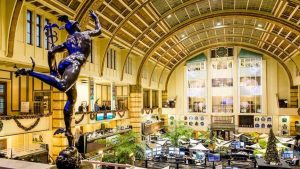For the Dutch version, click here.
Note in advance: This article was written as inspiration after reading the book “The Bomb Under the Barings/Roque Trader”. Good to know that the book has been filmed and can be seen freely on YouTube via this link! Also, Nick Leeson has been a guest on College Tour presented by Twan Huys which you can watch here!
Scandals come in all shapes and sizes. In June 2020, Wirecard collapsed as 2 billion on its balance sheet suddenly disappeared. The question was whether the 2 billion had existed at all. Arranger Jan Marsalek is still without a trace [1]. Would Marselek know about the story of Nick Leeson? This is a British trader who, because of his manipulations in the stock market and accounting, brought down the investment bank Barings. How could Nick Leeson have caused so much trouble without anyone doing anything about it? And how could Nick Lees escape at all and leave the bank with a huge debt? You’ll find out more in this article!
Background information and the road to Singapore
Nick Leeson was born in Watford and lived in “Two Worlds”. On weekends, he was in the pub in England with his friends who worked as plasterers or construction workers. Nick himself, however, had other ambitions. During the week he worked in the futures and options administration department of Morgan Stanley. Nick aspired to work on the trading floor and as a result, he left for Barings bank in the summer of 1989 [2].
Nick soon found out that the prospects of continuing to grow in London were limited. He moved to Indonesia. There Nick met his future wife Lisa and together they moved to Singapore. There, Barrings had secured a place on the Simex (Singapore International Monetary Exchange) and Nick was the ideal man to head up trading there. This finally gave Nick his chance to work in the stock market. What was remarkable is that Nick was barely supervised and even had double duties: trading on the exchange and then processing the administration. Because there was no separation of functions, Nick could do whatever he wanted, which made it possible for Nick to conceal loss-making positions.
Striving for success
His first major challenge was a £20,000 loss made by one of Nick’s traders. At this point, error account 88888 emerged. The sequence 88888 was created because 8 is a Chinese lucky number and each account must have five digits. Nick booked the loss on this account to protect one of his traders [3].
However, Nick was determined to make up for the loss he suffered and he began to take risks in the stock market. This initially worked out well for Nick and he managed to reduce his losses to profits and in doing so he even accounted for ten percent of the Barings bank’s income [4]. This result made him want even more, so through his speculations in the stock market, Nick began to make losses again, increasing to larger portions. Nick Leeson told Twan Huys in College Tour that he was overcome by greed for success, which eventually caused the loss of his position to reach 208 million pounds by the end of 1994 [5]. Yet he managed to hide these losses. In Money Talks, an RTL Z program, Leeson indicated that he was certainly not the first to hide losses in an illegal account. “It was normal practice to hide losses until you had made enough money again to offset the losses,” said the now 55-year-old Leeson [6].
“Leeson left a bill on his desk saying “I am sorry”.”
Luck, incompetence, or negligence from the Barings bank?
With such large losses, one would wonder why Barings did not intervene. On the one hand, Nick was lucky that every attempt at control, in often curious ways, fell his way. For example, for audit purposes, the bank sent from London to Singapore the director of Barings Brothers, who was in charge of internal audit and got to the bottom of everything. This audit was bound to catch Nick out and start asking questions for clarification of the losses posted to account 88888. Fortunately for Nick, this person was called back to London a day before the audit and the replacements were less sharp, allowing Nick to still pull the wool over Nick’s eyes [7]. On the other hand, it was also the Bank itself that did not see the need to intervene. After all, Nick was Barings’ revenue model. While there was a silence that there was no such thing as segregation of duties, Barings did not want to incur costs by hiring additional staff or risk jeopardizing their upcoming bonus [8]. In addition, money was constantly being transferred from London to Singapore. Nick indicated that he needed this to take the positions on the stock exchange, when in fact he was using the money to cover the losses. Eventually, the assets in Singapore were many times higher than allowed.
His losses were so high that Nick could also distinguish between his work and his private life. Despite this, Lisa did not find out about the huge losses Nick had made. After all, she was also stunned that while celebrating Christmas in London, Nick did not want to return to Singapore, while a hefty bonus was waiting for him in February. What Lisa didn’t know is that moments before, Nick had received a call from Singapore about an unexplained position of 7.78 billion yen, equivalent to $79 million, which made it impossible to reconcile the 1994 financial statements. In the hunt for survival, Nick then did the impossible: he forged the signatures of Spear, Leeds, Kellog (a stockbroker), Citibank, and Barings bank to ensure that this amount could be classified as credit paid to Barings. This filled the gap in the financial statements. Nick sent the forged endorsement from his flat to the accounting firm Coopers & Lybrand, who accepted the statement, even though the fine print at the bottom of the letter stated that the fax was sent from Nick and Lisa’s flat. Later Singaporean investigations revealed that Peter Norris and James Bax, CEO of Barings Investment Bank and Managing director of CEO, respectively, should have suspected that something was seriously wrong with this loan. [9].
The Escape
The Kobe earthquake [10] ended Nick Leeson. The stock market collapsed and Nick Leeson left a bill on his desk saying “I am sorry.” He then fled with Lisa to Malaysia on Thursday, February 23, 1995. After the weekend he saw himself in the newspaper, and Barings’ losses had risen to £820 million. Afraid of the trial that awaited him in Singapore, he tried to flee to London with the hope of being arrested and tried there. However, he just barely managed to reach London and was arrested in Frankfurt. After a months-long trial, he was still transferred to Singapore, where he eventually spent six and a half years in jail [11].
Conclusion
Now Nick Leeson lives in Ireland, has an academic degree in psychology, and was manager of Galway United soccer club until 2011 [12]. In the end, Nick Leeson proved not to be the biggest failure in the financial world. Over 13 years later after the Barings incident, the French bank Société Générale came under scrutiny as securities trader Jérôme Kerviel lost 4.9 billion euros with speculation on the futures market [13]. It remains to be seen whether the financial sector has learned from the scandals, or whether we will see yet another “roque trader” in the news in the coming years.














